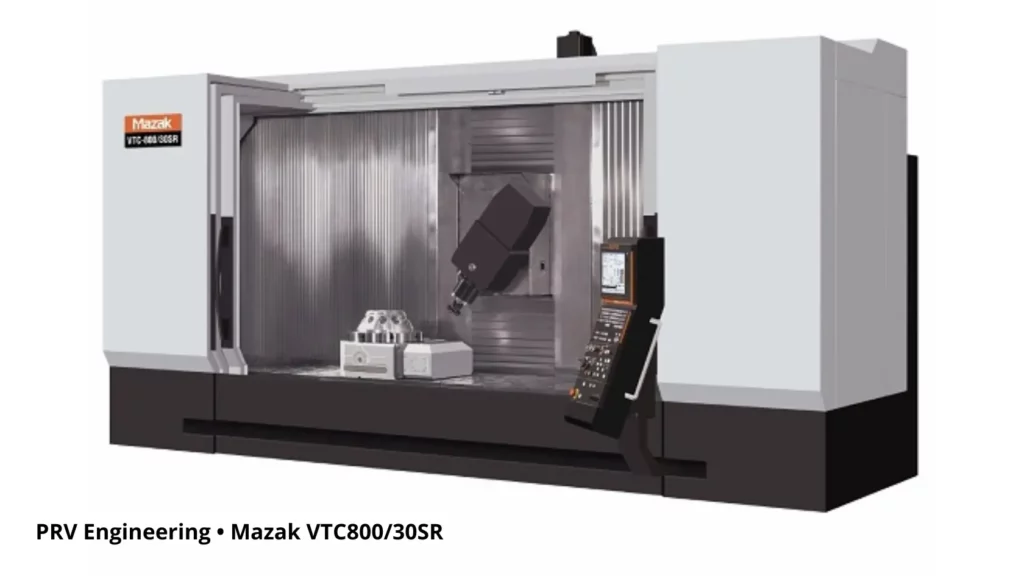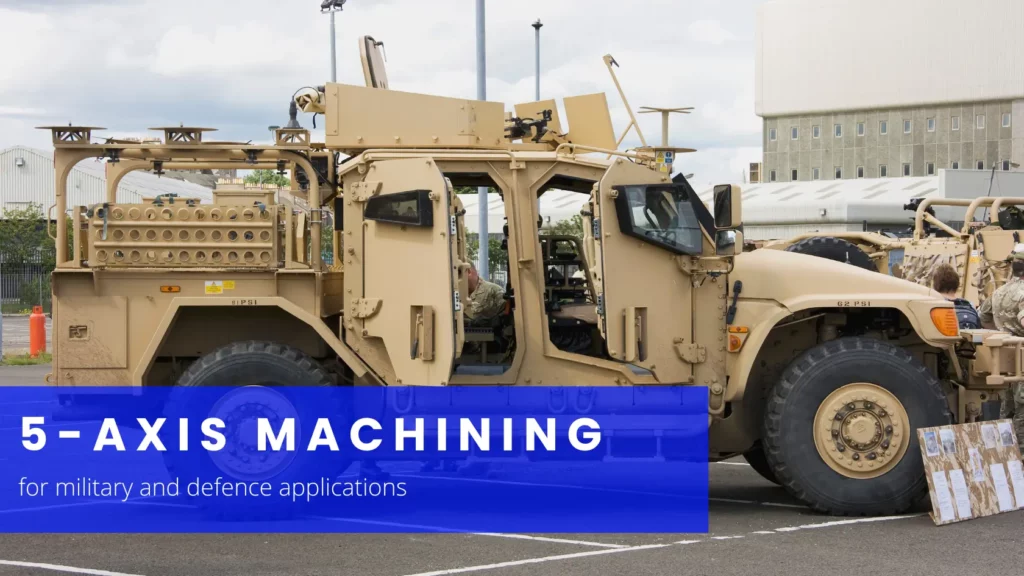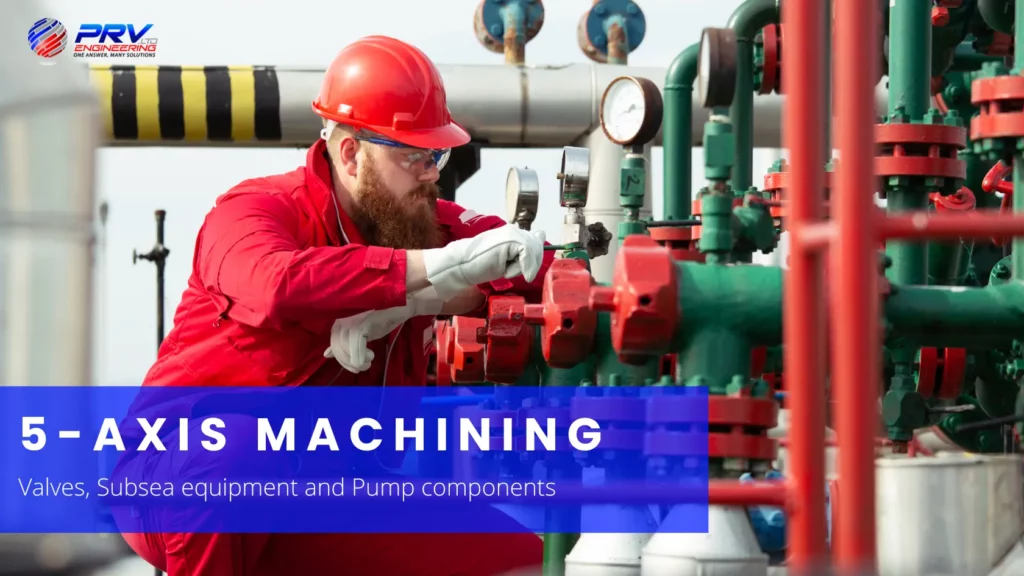
5-axis machining is a powerful tool for precision engineering, allowing manufacturers to create complex parts and components with extreme accuracy and efficiency. Precision engineering has always been an essential aspect of manufacturing, especially in industries such as aerospace, automotive and medical device manufacturing. In this article, we’ll explore the benefits of 5-axis machining, the different types, industry applications, 5-axis machining software and what the future of this technology might look like.
What is 5-Axis Machining?
5-axis machining is a precision engineering technology that involves the use of computer-controlled machines (CNC) to manufacture complex parts and components. Five-sided machining, also known as 3+2, is the process of setting up a part once and using a machine like the Mazak VTC800/30SR to machine five sides instead of machining the part one side at a time using a conventional 3-Axis machining centre.
With these advanced machines, tools can move in five different directions or axes (X, Y, Z, A, and B), enabling manufacturers to produce intricate and complex parts with high levels of precision and accuracy. This means operators can create applications that can machine intricate components in a single setup, eliminating the need for additional setups which drastically reduces cycle times.
Getting Started with 5-Axis Machining
If you’re interested in getting started with 5-axis machining, there are several steps you have to take before producing any parts or components.
First, you’ll need to find a reliable supplier of CNC machines that offer 5 axis capabilities. You’ll also need to invest in software that supports your specific application needs as well as training on how to use the software effectively.
Finally, you must develop a strategy for integrating your new equipment into your existing production processes in order to maximise efficiency while minimising costs.
How to Choose the Right 5-Axis Machining Software
Choosing the right software for your 5-axis machines is crucial to achieving the best results. Some factors to consider when selecting 5-axis machining software include:
- Compatibility with your machine: Ensure that the software is compatible with your specific machine to avoid compatibility issues.
- Ease of use: Look for software that is user-friendly and easy to learn, as this will reduce the learning curve for operators.
- Support for your specific applications: The software should support the specific applications you need to machine to ensure the highest level of precision and accuracy.
Benefits Of 5-Axis Machining
5-axis machining offers several key benefits that cannot be achieved with traditional 3-axis milling machines. It allows for more complex geometries and shapes to be machined, resulting in higher accuracy and precision. It has several advantages that make it an ideal solution for intricate parts and components, including the following:
- Increased accuracy – The ability to manipulate the cutting tool on multiple axes allows manufacturers to achieve extreme accuracy in each cut, thus producing more precise parts.
- Improved productivity – By cutting multiple sides of the part in one go, 5-axis machining dramatically reduces the production time needed to create complex components.
- Greater flexibility – With 5-axis machining, manufacturers can easily modify part designs without having to completely re-tool their machines.
- Reduced waste – By cutting more efficiently, 5-axis machining helps reduce the amount of wasted material and energy.
Types Of 5-Axis Machining
5-axis machining involves multiple simultaneous linear and rotary movements for a variety of types of machining operations. Here are some of the most common types of 5-axis machining:
CNC Contouring
This type of machining is used to cut complex contours, such as curved or angled surfaces. It is most commonly used for aerospace and biomedical applications. The CNC contouring process is a precise technique used to provide an exquisite finish on components of any peculiar shape, including curved, rounded and irregular surfaces.
CNC Milling
This technique is used to produce parts that require detailed internal features. It involves cutting away material from a part and is used for complex parts such as turbine blades and medical implants. CNC milling is a precise, repeatable technique that offers superior accuracy and finish quality for intricate parts.
CNC Turning
Turning involves cutting materials into the desired shape and size. It is commonly used for automotive parts, such as engine blocks, shafts and bearings. This type of machining is also used to create components with holes, threads and grooves.
Turn-Milling
Turn-Milling machines combine turning and milling operations to produce complex components with a single setup. It is used in industries such as automotive, aerospace, and medical device manufacturing to produce parts with multiple features and intricate shapes.
Drilling
This type of machining is used to create holes in a workpiece, and it requires precise control over the spindle speed and feed rate. It can also be used on both ferrous and non-ferrous materials, as well as plastics and composites. It can be performed using either standard drills or specialised tools such as reamers and taps.
Industry Applications Of 5-Axis Machining
With the ability to produce complex parts in a single setup, 5-axis machining has revolutionised precision engineering. It has given manufacturers the tools to produce intricate and complex parts with exceptional precision and accuracy. Let’s take a closer look at some of the industry applications of 5-axis machining.
Aerospace Engineering
Aerospace is one of the industries where this machining method has had a significant impact. The industry demands high-precision parts with tight tolerances, and 5-axis machining has proven to be an invaluable tool in achieving these standards. With this technology, manufacturers in the aerospace industry can produce complex parts which require intricate geometries to maximise efficiency and performance, including:
- engine components
- wing spars
- fuel nozzles
- landing gear parts
- turbine blades
Medical Device Manufacturing
Medical device manufacturing is another industry where 5-axis machining is widely used. With the increased demand for smaller, lighter and more complex medical devices, precision engineering has become crucial in this sector. 5-axis machining has proven to be a game-changer in producing high-precision medical devices such as surgical instruments, implants, and prosthetics. It enables manufacturers to produce complex geometries with high accuracy, reducing the risk of human error and improving patient outcomes.
Recommended: Advances in Medical Technology
5-axis machining In Military Applications
5-axis machining has become an essential tool in military and defence applications, enabling manufacturers to produce complex parts and components that are critical to mission success. From weapons systems to aircraft components, 5-axis machining is used to produce high-precision parts with tight tolerances and complex geometries.
Some of the military applications include:
- Tanks, armoured vehicles and APCs (Armoured Personnel Carriers)
- Missiles and weapon systems
- Gun components
- Components for communication and surveillance systems
Automotive Engineering
Manufacturers are using 5-axis machines to produce engine blocks, cylinder heads and other components with complex geometries that require high-precision machining. This technology has also enabled the production of lightweight parts for electric and hybrid vehicles where weight reduction is critical for maximising battery life and performance.
Tool and Die Making
5-axis machining is used in the tool and die making industry to produce precision cutting tools, dies, moulds, and fixtures with superior accuracy. This type of machining helps manufacturers create complex parts quickly and efficiently while maintaining high levels of quality control.
Also Read: Design for Manufacture: How To Save Money On Mould Tooling
Consumer Goods
5-axis machining is used in the consumer goods industry to produce products such as toys, electronics, and household appliances. The ability to machine complex parts quickly and accurately enables manufacturers to create high-quality products without sacrificing production efficiency.
Marine Engineering
Marine engineering is another industry where 5-axis machining has become increasingly prevalent. One of the primary applications of 5-axis machining in marine engineering is the production of propellers require high precision and accuracy to function effectively. However, it is also used to produce other critical components for the marine industry, including shafts, bearings, and flanges.
At PRV Engineering, we provide precision machining and custom fabrication services, including boat cradles, fabricated skids and brackets, steel stillage and coded welding among many others. We use advanced CNC technology for precision machining and fabrication that meets the highest industry standards. Visit our website to learn more about us and our engineering services in the UK.
5-Axis Machining In Oil & Gas
The precision of 5-axis machines means more durable parts that can withstand high pressure and extreme temperatures; certainly something the oil & gas sectors requires. Some of the parts and components produced include:
- Valves
- Subsea equipment
- Pump components
- Drill bits
The Continued Impact Of Precision Engineering
The demand for precision engineering has only increased with the rapid advancement of technology and the higher demand for more complex parts. This continued growth has led to the development of new materials, processes, and tools that enable manufacturers to produce more intricate and complex products that are of superior quality, more consistent and boast improved safety and performance in various applications.
With the growing demand for precision engineering, the industry is poised to continue to grow and evolve in the coming years, leading to further advancements and innovation in manufacturing. Advancements in software and automation, for example, are driving the development of new manufacturing processes that allow for the production of highly complex parts with minimal human intervention.
This trend towards automation and digitalisation in manufacturing is expected to continue to transform the manufacturing industry in the coming years.
Conclusion
5-axis machining has become an essential part of modern manufacturing due to its ability to produce complex parts rapidly and accurately. With the help of this technology, manufacturers can reduce costs, increase efficiency and improve product quality. As the industry continues to evolve, 5-axis machining is expected to become even more widely used in the coming years. With its numerous benefits and wide range of applications, it’s no surprise that this technology offers great potential for manufacturing businesses in the future.
5-Axis Machining At PRV Engineering
As technology advances, 5-axis machining is becoming more accessible and affordable for small and medium-sized manufacturers. Additionally, the development of new materials and the increasing demand for complex parts are driving the need for 5-axis machining in various industries.
5 axis machines, with their ability to create complex parts and profiles with incredible speed and accuracy, without the need to re-set work pieces have become the ‘must-have’ equipment in manufacturing. At PRV Engineering, we continuously invest in new tools, technology, equipment and staff training so we can provide the best possible service to our clients.
If you want to know more about what our 5-axis machining centre can produce, call us on 01495769697 or submit an online enquiry through our website.


 Mail:
Mail: 






